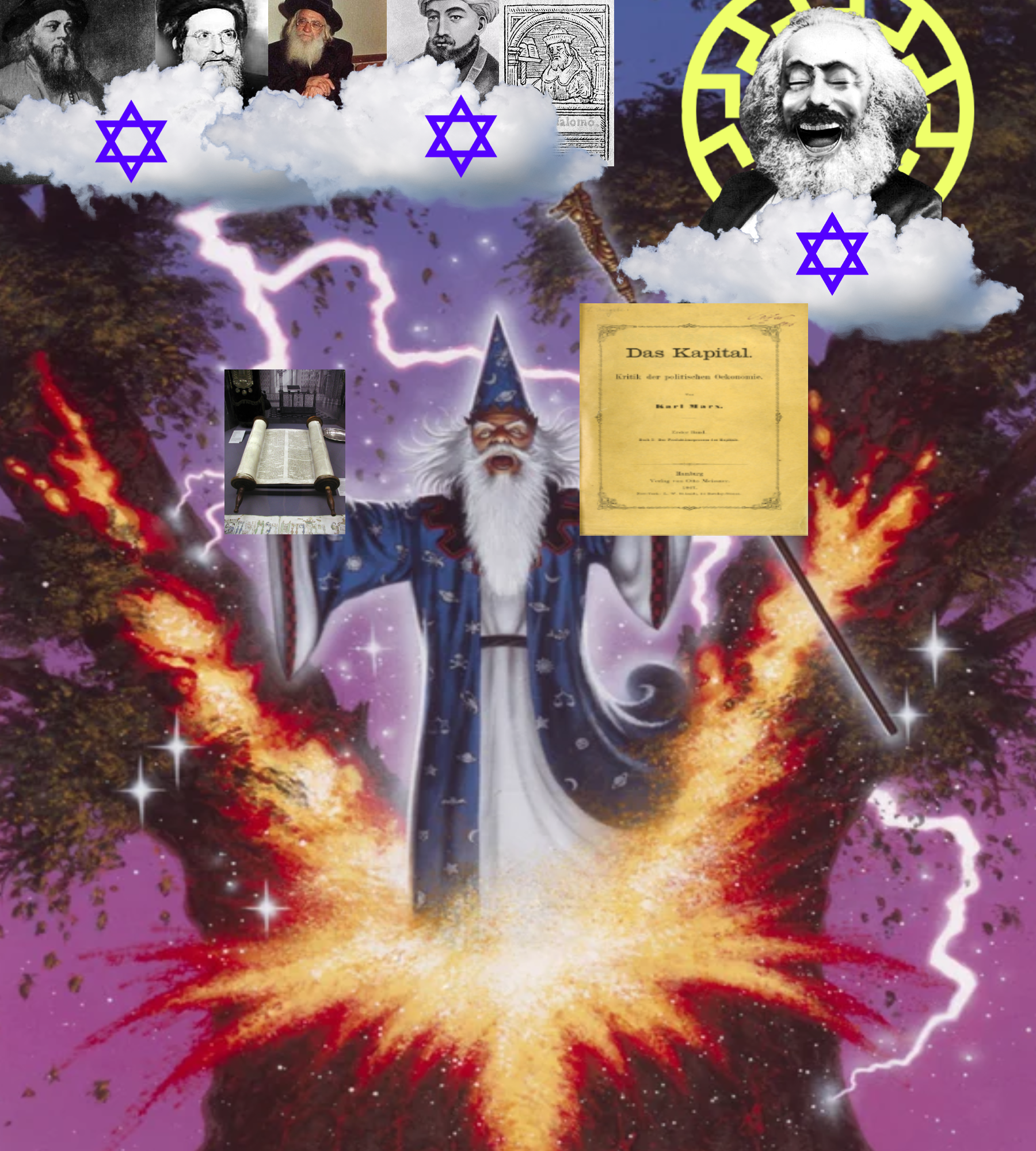

|
Marxism and Kabbalistic thought: Introduction - Unveiling Allegorical Parallels, or Communism as a secular entry of Judaism in the non-jew world -Homepage- -About- -Essays- -Translate to french- |
|
Philosophy serves as a tapestry woven from diverse threads of thought, and within this intricate weave, unexpected connections often emerge. Such is the case with the juxtaposition of Marxism, a socio-political theory critiquing capitalism, and Kabbalistic thought within Judaism, an esoteric mystical tradition. At a surface level, these ideologies may seem irreconcilable, but a deeper examination reveals allegorical parallels that suggest a shared conceptual foundation. This essay delves into the core tenets of Marxism, illuminating its key points, and subsequently engages in an in-depth exploration of its striking resonances with Kabbalistic ideas, particularly inspired by the teachings of Rabbi Yehuda Ashlag. Ultimately, we will assert the intriguing notion that Karl Marx can rightfully be considered a Jewish philosopher, his ideas functioning as an allegory for Jewish spiritual concepts translated into socio-political language. I. Allegorical Comparison with Kabbalistic Thought: A. Spiritual Dialectics and Historical Dialectics: To appreciate the intriguing allegorical parallels between Marxism's historical dialectics and Kabbalistic spiritual dialectics, we must delve deeper into each concept. Marxism's historical dialectics, as expounded by Karl Marx and Friedrich Engels, posit that history is driven by the perpetual conflict between socio-economic classes. This struggle unfolds through various epochs, leading ultimately to a classless society, characterized by the collective ownership of the means of production. The materialist conception of history asserts that the material conditions of society, particularly the modes of production, shape the course of history. In stark contrast, Kabbalistic thought, influenced by the teachings of Rabbi Yehuda Ashlag, introduces us to the concept of spiritual dialectics. In Kabbalah, the cosmos is viewed as a complex interplay of opposing forces, often symbolized by the interaction between the sefirot, the ten attributes that emanate from the divine. These forces are in constant tension, striving towards a harmonious equilibrium known as "Tikkun" or cosmic rectification. At first glance, the distinction between material historical dialectics and metaphysical spiritual dialectics may seem insurmountable. However, a closer examination reveals a fundamental commonality—the dialectical nature of existence. In both Marxism and Kabbalah, the universe is depicted as a dynamic interplay of opposing forces, whether they be socio-economic classes in the material world or spiritual attributes in the metaphysical realm. The allegorical connection here lies in the suggestion that the material struggles of society might be a terrestrial reflection of the intricate spiritual dynamics that underlie the Kabbalistic universe. While one realm deals with material forces and the other with metaphysical ones, the fundamental dialectical essence shared by both brings them into unexpected resonance. It hints at a deeper, universal truth—the inherent tension and resolution, the conflict and harmony, that define our existence, whether we view it through the lens of socio-political evolution or mystical spirituality. B. Liberation and Redemption: The allegorical alignment between Marxism's focus on the liberation of the proletariat and Kabbalistic ideas of humanity's journey towards redemption brings forth a profound narrative of human struggle and aspiration. In Marxism, liberation is framed as the emancipation of the working class from the chains of capitalist exploitation. Marx envisions a world where the means of production are collectively owned, where class distinctions dissolve, and where the proletariat, having thrown off the yoke of bourgeois oppression, governs collectively. This liberation narrative, rooted in socio-economic and political transformation, resonates deeply with the human desire for freedom and justice. Conversely, Kabbalistic thought offers a narrative of humanity's fall from a higher, more harmonious state of existence and its quest for redemption and restoration. According to Kabbalah, humanity's actions in the physical world have cosmic significance, impacting the delicate balance of spiritual forces. Redemption, in this context, involves a return to a state of cosmic equilibrium, a reunion with the divine source. The comparison here underscores the universal human yearning for liberation from forces that constrict potential and growth. Whether one interprets it as the proletarian's struggle for social justice or as the soul's journey toward spiritual redemption, the narrative carries the same underlying message—a longing for freedom, wholeness, and the realization of human potential. This convergence serves as a testament to the shared human experience of aspiration and transformation, regardless of whether it is framed in socio-economic or spiritual terms. C. Unity and Collective Consciousness: The allegorical resonance between Marxism's vision of a classless society and Kabbalistic ideas of unity among all aspects of creation opens a gateway to understanding the shared threads of collectivism that weave through these seemingly distinct ideologies. Marxism envisions the ultimate dissolution of socio-economic classes, transcending the boundaries that have historically divided society. In a classless society, there is no bourgeoisie or proletariat, no exploiter or exploited. Instead, there is a collective ownership of the means of production, and resources are distributed based on need rather than profit. This vision, while firmly rooted in material and economic terms, reflects a profound yearning for unity among humanity. Kabbalistic thought, particularly influenced by Rabbi Yehuda Ashlag, emphasizes the interconnectedness of all souls and proposes a collective consciousness that transcends individualism. According to this perspective, each soul is a fragment of a greater whole, and our ultimate purpose is to reunite with this cosmic oneness. Unity, in Kabbalah, is not limited to human souls but encompasses all aspects of creation, forming an intricate tapestry of interconnectedness. The intersection highlights a shared vision—the aspiration for unity and the dissolution of divisive categorizations. Whether it is the dissolution of socio-economic classes in Marxism or the dissolution of the illusory barriers between souls in Kabbalistic thought, both ideologies converge on the concept that true harmony and progress emerge from a state of collective unity. This confluence of vision hints at a shared thread between the socio-political realm and the spiritual dimension, where unity is not merely an abstract concept but a fundamental truth that binds all aspects of existence. II. Marx as a Jewish Philosopher: The allegorical parallels we've unveiled between Marxism and Kabbalistic thought, particularly through the teachings of Rabbi Yehuda Ashlag, raise a compelling and intriguing question: Can Karl Marx be rightfully regarded as a Jewish philosopher, his ideas functioning as an allegory for Jewish spiritual concepts translated into socio-political language? This question invites us to reconsider Marx's intellectual heritage. While Marx's work predominantly resides in the realm of socio-economic and political critique, his ideas bear profound philosophical and even spiritual implications. The allegorical exploration of Marx's concepts as a secular rendering of spiritual insights outlined by Rabbi Ashlag's Kabbalah offers a fresh perspective on Marx's intellectual legacy. It's crucial to clarify that suggesting Kabbalah directly influenced Marx is not the objective here; rather, the focus is on unraveling shared allegorical themes that echo across diverse ideological landscapes. Just as Kabbalah presents a cosmic narrative of creation, fall, and redemption, Marxism portrays a socio-political narrative of oppression, resistance, and liberation. This exploration reveals the hidden unity of seemingly disparate ideologies. In essence, the philosophical depth of Marx's ideas invites us to consider him not merely as a socio-economic theorist but as a thinker whose concepts resonate with profound spiritual and philosophical dimensions. His work, far from being confined to the realm of political economy, might be seen as an allegorical reflection of universal truths expressed through the lens of socio-political critique. Conclusion: The exploration of allegorical parallels between Marxism and Kabbalistic thought, particularly through the teachings of Rabbi Yehuda Ashlag, unveils a captivating bridge between the realms of socio-political critique and spiritual mysticism. Marx's emphasis on class struggle, liberation, and unity resonates with the spiritual journey outlined within Kabbalistic teachings. Although Marx's intent may not have been to align his theories with Jewish mysticism, the alignment between Marxism and Kabbalah underscores the profound interconnections that philosophy can unveil. In light of these allegorical correspondences, the proposition that Karl Marx can be considered a Jewish philosopher gains traction. His ideas, rather than arising as mere socio-political commentary, manifest as an allegorical portrayal of Jewish spiritual concepts transposed" 
Written by © Savalleh, 2023
| |